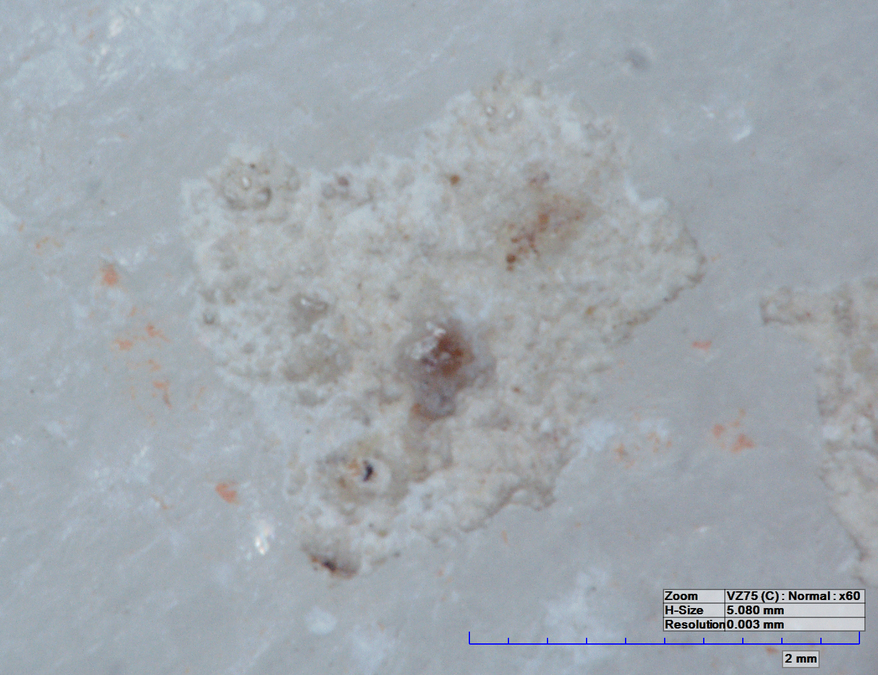Maximus
Summary
The technical examination of IN 826 provides new insight into the colour palette and painting techniques on polished marble portraits from Antiquity. On the portrait’s polished parts scattered particles of red and yellow ochre, Egyptian blue and carbon black are found as part of the carnation colour. This indicates that carnation colour was used on the polished portrait. The iris was outlined with a thin black line and the rim of the eyes bore a delicate pink colour made of lead, cinnabar and ochre. Shades of red, together with black and Egyptian blue, were used for the hair.
Description of object
The portrait is that of a clean-shaven young man with his hair cut short. The strands of hair are represented with a point and a flat chisel, creating a hatched, punctuated surface texture. The chisel is also used to accentuate the individual hairs of the eyebrows, while the pupils are drilled. The skin surface of the portrait is polished to a high gloss resembling porcelain, which stands in a sharp textural contrast to the chiselled hair.
The portrait is well preserved. However, it is broken by the neck and the nose is missing. The rims of the ears are missing too. The right side of the face and the main part of the hair are covered in encrustation.
Choice of methods
Visual examination
- Macroscopic
- Microscopic in situ
Technical imaging
- UV
- VIL
- Raking light
Sampling
- XRF
- Petrographic analysis
Marble identification method
- EPR and isotopic analysis.
Visual examination
The portrait’s hair reveals scattered, coloured particles and occasionally small fragments of a distinct paint layer. Variations of red dominate together with a few black and blue grains. A few yellow grains are also observed and usually integrated in secondary crusting. A dark red layer is found on the portrait’s fringe and on the left side of an orange-red layer is found as hair colour.
In the eyebrows and eyes scattered red dominates together with a few black and blue grains. Traces of cohesive paint layers are also found. The right iris is outlined in black and along the upper rim a compact pink layer is observed.
On the right side of the face, which is, for the most part, covered in secondary crusting, traces of colour are observed. Red grains are embedded in the calcareous layer together with a few black and blue grains. Furthermore, a few yellow grains are documented. On the left side of the face only faint traces of red colour are found on the polished surface.
Technical imaging
UV-FL: Imaging does not reveal fluorescent phenomena related to organic dyes or coatings."":/objects/125/attachments/407
VIL: Imaging reveals an intentional use of Egyptian blue on both hair and skin. The strong luminescence of Egyptian blue in combination with the transparent properties of the calcareous crust make it possible to identify an even distribution of particles of Egyptian blue on the right side of the face. Only a few grains of Egyptian blue are found in the eyes and it remains inconclusive as to whether the blue was used for the iris and/or the white of the eyes. Egyptian blue was also part of the colour palette used for the hair.
Other types of investigation
XRF-analysis:
The dark red layer in the fringe consists of ochre (Fe, 951 ppm) and small amounts of copper (Cu, 18 ppm), lead (Pb, 45 ppm) and zinc (Zn, 78 ppm).
The orange-red layer on the left side of the head consists of ochre (Fe, 311 ppm) and zinc (Zn, 24 ppm).
The pink layer running along the upper rim of the right eye is mixture of ochre (Fe, 502 ppm) and small amounts of zinc (Zn, 26 ppm), lead (Pb, 21 ppm) and mercury (Hg, 17 ppm).
Polished part with red paint on top reveal ochre (Fe, 564 ppm), lead (Pb, 21 ppm) and tin (Sn, 118 ppm).
Bibliography
A. Skovmøller and R. Therkildsen (2011), On the High Gloss Polish of Roman Sculpture. In: J.S.Østergaard (ed.). __Tracking __Colour, Preliminary Report 3, 2011, Ny Carlsberg Glyptotek, 35-46.
F. Johansen (1995), Roman Portraits, III. Ny Carlsberg Glyptotek, Copenhagen, 106-107.
- IN 826
- Portrait
- 235-238 CE
- Roman Imperial
- White Göktepe marble
- Acquired 1890 from Alberici in Rome, through the agency of Helbig.
- H. 34 cm.




















